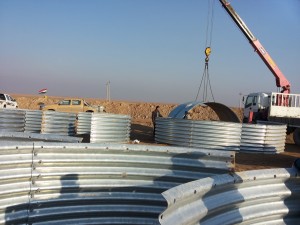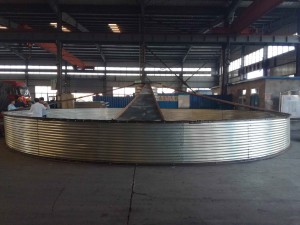The assembled corrugated culvert pipe is made of several pieces of corrugated plates fixed with bolts and nuts, with thin plates, light weight, easy to be transported and stored, simple construction process, easy to be installed on-site, solving the problem of destruction of bridges and pipe culvert structures in cold areas, with fast assembly, short construction period and other advantages.
Pipe section assembly and connection of assembled corrugated culvert pipe
1、Pre-construction preparation: check the flatness, elevation of the bottom of the culvert pipe and the setup of the base foreseen arch, determine the position, center axis and midpoint of the culvert pipe.
2、Assembling the bottom plate: take the center axis and midpoint as the reference, the first corrugated plate is positioned, and extends to both sides with this as the starting point until the two ends of the culvert pipe import and export; the second plate is stacked on top of the first one (lap length is 50mm), and aligned with the connecting holes. The bolt is inserted into the screw hole from the inside to the outside, the opposite side of the set of washers nut, pre-tighten the nut with a socket wrench.
3、Assembling ring ring from the bottom upwards in turn: lap part of the upper plate covering the lower plate, circumferential connection using stepped, that is, the upper two boards connecting the stacked seams and the following two boards of the stacked seam misalignment, connecting the stacked seams misalignment, connecting the holes right after the bolts are inserted from the inside out into the screw holes, pre-tighten the nut with a socket wrench.
4, each meter length assembled after molding, to determine the shape of the cross-section, to meet the standards and then continue to assemble, less than the standard should be adjusted in a timely manner. Circumferential assembly to the ring when the ring together, determination of cross-sectional shape, using positioning tie rod fixed, adjust the pre-tensioning bolts, assembling corrugated pipe.
5、After all the culvert pipe assembling is completed, use fixed-torque steam wrench to tighten all the bolts according to the torque of 135.6~203.4N-m, in order of sequence, not to be missed, and the bottom bolts are marked with red paint after tightening. All bolts (including longitudinal and circumferential joints) should be tightened before backfilling to ensure that the overlapping parts of the corrugation are tightly nested together.
6. To ensure that the required value of bolt torque moment is achieved, randomly select 2% of the bolts on the longitudinal joints on the structure before backfilling, and carry out a sampling test with a constant torque wrench. If any bolt torque value range does not reach the required value, then 5% of all bolts in longitudinal and circumferential joints should be sampled. If all of the above sampling tests meet the requirements, the installation is considered satisfactory. Otherwise, it should be rechecked to determine whether the measured torque value meets the requirements.
7、After the bolts at the lap joint of the outer ring are tightened and meet the requirements, in order to prevent water seepage at the seams of corrugated steel plate and bolt holes, special sealing materials are used to seal the steel plate joint and bolt holes to prevent water seepage at the corrugated plate joint.
8, after the installation is completed, in the pipe inside and outside the uniform brush two asphalt, asphalt can be hot asphalt or emulsified asphalt, asphalt layer should be less than the total thickness of 1mm.
Post time: Jun-06-2024








